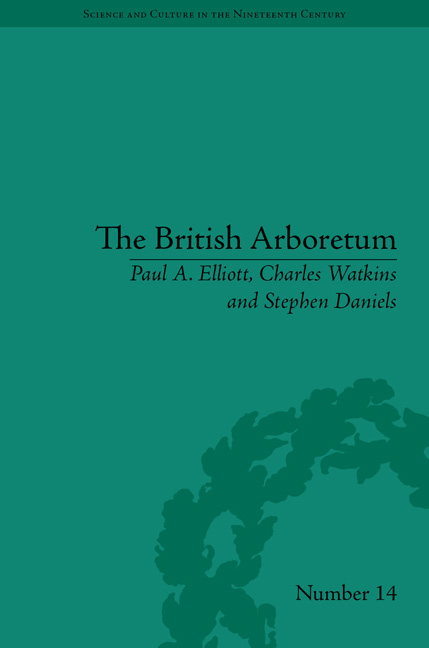Book contents
- Frontmatter
- CONTENTS
- List of Figures
- Preface
- Introduction
- 1 British Tree Cultures in the Nineteenth Century
- 2 Trees and Taxonomy
- 3 British Arboriculture, c. 1800–35
- 4 John Claudius Loudon's Arboretums
- 5 The Botany of the Arboretum Britannicum
- 6 The Derby Arboretum
- 7 Estate Arboretums
- 8 Public Urban Arboretums
- 9 The Transformation of Victorian Public Arboretums
- Conclusion
- Notes
- Works Cited
- Index
3 - British Arboriculture, c. 1800–35
- Frontmatter
- CONTENTS
- List of Figures
- Preface
- Introduction
- 1 British Tree Cultures in the Nineteenth Century
- 2 Trees and Taxonomy
- 3 British Arboriculture, c. 1800–35
- 4 John Claudius Loudon's Arboretums
- 5 The Botany of the Arboretum Britannicum
- 6 The Derby Arboretum
- 7 Estate Arboretums
- 8 Public Urban Arboretums
- 9 The Transformation of Victorian Public Arboretums
- Conclusion
- Notes
- Works Cited
- Index
Summary
Loudon's Arboretum Britannicum has had a profound impact on the history of British arboriculture ever since its publication, unavoidably obscuring arboricultural works published prior to this and shaping subsequent interpretations of nineteenth-century tree collections. To fully contextualize Loudon's magnum opus and to appreciate its significance in the history of natural history we will examine some preceding arboretums and arboricultural works. This chapter argues that botanical society gardens were the first type of public and semi-public urban institutions with significant tree and shrub collections prior to the 1820s and that the challenges of applying Linnaean botany to arboriculture were first confronted leading to experiments with natural arrangements. Newly imported trees and shrubs were eagerly sought and presented but challenged taxonomic ideas and gardening practices, underscoring tensions between practical botany, education, popular natural history and publications. From the late eighteenth century, British botanical gardens began to present natural alongside Linnaean arrangements which impacted upon arboricultural publications such as Aylmer Bourke Lambert's Genus Pinus (1802–24) and Peter William Watson's Dendrologia Britannica (1825).
Older purposes of physic gardens were not entirely forgotten and, aided by active patronage from medical men, the potential to exploit plants for medicinal uses remained important, rhetorically if not often in practice. However, British botanical gardens and arboretums helped to develop and satisfy a new audience for botanical and arboricultural education. Private and semi-private institutions relied upon income from members, patrons and visitors whose expectations of the gardens had to be satisfied.
- Type
- Chapter
- Information
- The British ArboretumTrees, Science and Culture in the Nineteenth Century, pp. 59 - 82Publisher: Pickering & ChattoFirst published in: 2014

